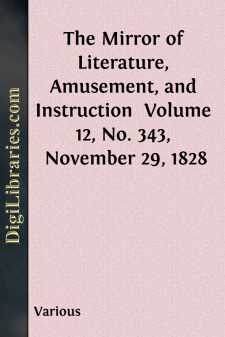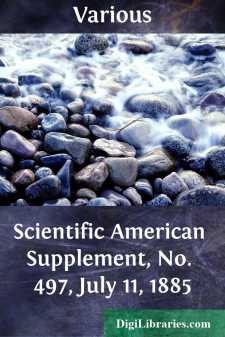Categories
- Antiques & Collectibles 13
- Architecture 36
- Art 48
- Bibles 22
- Biography & Autobiography 813
- Body, Mind & Spirit 142
- Business & Economics 28
- Children's Books 15
- Children's Fiction 12
- Computers 4
- Cooking 94
- Crafts & Hobbies 4
- Drama 346
- Education 46
- Family & Relationships 57
- Fiction 11828
- Games 19
- Gardening 17
- Health & Fitness 34
- History 1377
- House & Home 1
- Humor 147
- Juvenile Fiction 1873
- Juvenile Nonfiction 202
- Language Arts & Disciplines 88
- Law 16
- Literary Collections 686
- Literary Criticism 179
- Mathematics 13
- Medical 41
- Music 40
- Nature 179
- Non-Classifiable 1768
- Performing Arts 7
- Periodicals 1453
- Philosophy 64
- Photography 2
- Poetry 896
- Political Science 203
- Psychology 42
- Reference 154
- Religion 513
- Science 126
- Self-Help 84
- Social Science 81
- Sports & Recreation 34
- Study Aids 3
- Technology & Engineering 59
- Transportation 23
- Travel 463
- True Crime 29
The Mirror of Literature, Amusement, and Instruction Volume 12, No. 343, November 29, 1828
by: Various
Categories:
Description:
Excerpt
THE ADMIRALTY-OFFICE.
The Admiralty Office, Whitehall, has few pretensions to architectual beauty. It is, however, to use a common phrase, a commanding pile, and its association with Britain's best bulwarks—her NAVY—renders it an interesting subject for representation.
The Admiralty-office adjoins to the north side of the Horse Guards, and was erected by Ripley, in the reign of George II., on the site of Wallingford House. It recedes from, but communicates with, the street by advancing wings, and is built principally of brick. In the centre of the main building is a lofty portico, of the Ionic order, the taste of which is not entitled to much praise. It consists of four columns, and on the entablature is an anchor in bold relief. Here are the offices, and the spacious abodes of the lords commissioners of the admiralty, together with a handsome hall, &c. On the roof of the building is a Semaphore telegraph, which communicates orders by signal to the principal ports of the empire.
But the most tasteful portion of the whole, is a stone screen, by Adams, in front of an open court, and facing the street. The style is exceedingly chaste and pleasing, and the decorations are characteristic naval emblems, finely executed. The representation of two ancient vessels in the end entablatures, merit especial notice.
Since the appointment of the Duke of Clarence to the office of lord high admiral, the Admiralty has been the town residence of his royal highness. The exterior has been repaired, and the interior in part refitted. The screen has likewise been renovated with much care, and two of the entrances considerably enlarged, but with more regard to convenience than good taste. The portion occupied by the royal duke contains a splendid suite of state rooms, within whose walls have frequently been assembled all the bravery, as well as rank, of the empire; for the interests of the noble service are too dear to his royal highness to be eclipsed by the false lights of wealth or fashion.
(For the Mirror.)
Plus ne suis ce que j'ay esté
Et ne le scaurois jamais estre,
Mon beau printemps et mon esté
Ont fait le saut par la fenestre.
Amour! tu as esté mon maistre
Je t'ai servi sur tous les Dieux,
O si je pouvois deux fois naistre,
Comment je te se virois mieux!
Imitation.I am no more, what I have been
And ne'er again shall be so.
My summer bright, my spring time green,
Have flown out of the window.
Oh love, my master thou hast been,
I, first of gods, instal thee,
Oh! could I e'en be born again,
Thou doubly would'st enthral me.
D.M.
TEMPLE AT ABURY.
(To the Editor of the Mirror.)
There is an inconsistency in the account of Abury in No. 341, perhaps overlooked by yourself.
I would ask, how could that arrangement of the fabric, so fancifully and ingeniously described by Stukely, be intended to represent the Trinity, when the place was confessedly in existence long anterior to Christianity? nor is there any thing in the old Druidical or Bardic tenets that can be twisted to any such idea....












